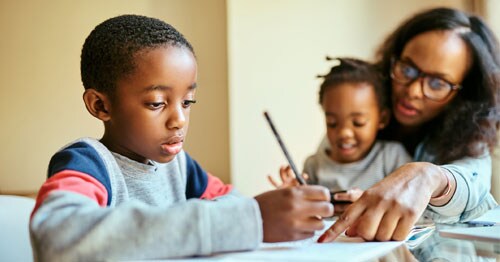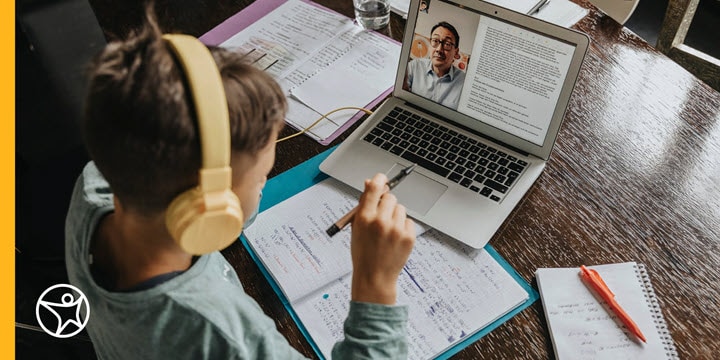A Focus on Resilience: Youth Building - Tips for Priming Resilience
by Mollie Marti
byAlyssa Austin
5 min to readParents and teachers everywhere are helping their students navigate another school year of distance learning. This new model shows no signs of slowing down, with 60% of parents indicating that they would consider staying with online school even after the pandemic. And even though the challenges of online distance learning can be significant, success is possible with the right game plan.
As the leader in online education, we’re here to share what we’ve learned over the past 20 years about how to teach online school from home. Read on to learn some new remote learning solutions to help your child thrive in homeschool, distance learning, and more.
Here are six solutions to common distance learning challenges for both teachers and parents:
One of the top homeschooling problems (and solutions for success) involves translating existing lesson plans. Experienced teachers likely have an assortment of lesson plans designed for in-person learning but may not know how to teach them online. Proven in-person protocols and assignments can be adapted for distance learning by breaking them into a mix of LiveLesson® sessions, active learning, and other assignments.
The entire school day doesn’t have to be spent on video calls or LiveLesson® sessions. Consider putting students into smaller groups for a project or having them work before the LiveLesson® session. This allows them to ask questions to ensure they understand the concepts being presented. And get creative! Update your lesson plan to make the most of distance learning and find new, exciting online learning solutions. For example, high school students can take advantage of educational virtual reality and learn biology through the World of Cells app, made by Pearson Education.

Another one of the most common distance learning problems and solutions is feeling scattered and disorganized. This is why having a home base for important information is critical during distance learning. Choose a home base where students and parents can access a consistent and detailed schedule, assignments, and other updates.
At Connections Academy®, this is done within our online learning portal, which varies by state. Usually this is your learning management system, Google Classroom, email, or a class web page. Communicate important information using a variety of methods. Some teachers also include a Slack group, message board, or chat room where information is shared. Creating a reliable place where students and parents can go for answers provides flexibility and promotes independent learning. Want to make a flexible class schedule for your students? Check out our five student sample schedules and download our blank template for yourself!
One of the biggest questions we hear from teachers is about building a class community without meeting in person. Things like pronouncing a student’s name correctly and learning about their interests promote a sense of belonging with distance learning. Teachers are thinking outside the box and using virtual icebreaker activities at the beginning of every class to help students feel comfortable engaging in online class discussions. Some are creating custom avatars, like Bitmoji, for the entire class as a creative solution of distance education, adding a fun visual element and allowing students to showcase their personalities.

In online classes, opportunities to integrate technology are almost endless, which can create both distance learning problems and solutions. Innovative educators leverage technology like virtual whiteboards, discussion forums, interactive notebooks, surveys, and videos to teach their curriculum and communicate with students. Remember: technology should always be appropriate to the grade level, and it’s important to give students time to learn new tools. At Connections Academy, we use the Pearson Online Classroom learning portal. Younger students only spend 15‒30 percent of their time on the computer, whereas high school students spend more time on it.
One of the top challenges of online distance learning is the shorter attention span for screen time. Therefore, it’s essential to set realistic expectations for how long online lessons should be. In virtual classrooms, planning shorter lessons helps students stay focused and allows them to take breaks when they need them. To keep students’ attention, especially during LiveLesson® sessions, teachers can encourage participation using polls, chat features, have the class take a virtual field trip to the moon, and even turning lessons into games by awarding participation points. By gamifying participation, a lecture turns into a fun and engaging learning activity.

One of the benefits of online learning is that it gives teachers opportunities to provide extra support to students who need it. To improve learning outcomes, Connections Academy teachers take advantage of one-on-one time for students who need more help. Teachers can use private surveys or ratings to identify students who may benefit from alternative assignments or additional explanations of key concepts. Some students may need a visual aid or slides to follow during a LiveLesson® session, while others may benefit from a worksheet to fill out. Taking the time to fine-tune learning methods pays off, especially with distance education.
Regardless of the specific distance learning problems you may be experiencing, the good news is that implementing some proven tactics can make a significant impact. Whether you are following a homeschool, online school, learning pod, or another blended education model, the best practices for teachers (and parents-turned-teachers) fortunately remain the same when it comes to teaching online classes.
The best practices in teaching online and in-person classes include:
These best practices work well as both blended and online school solutions. Implementing these tools will create a more efficient remote learning environment and help your child thrive.
We’ll keep sharing best practices and ideas for blended and online school solutions—in whatever model you have chosen. We’re in this together.
